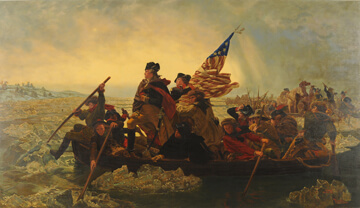Did You Know?: 'Washington Crossing the Delaware' painting
February 13, 2014
 |
|
An authorized copy of "Washington Crossing the Delaware" hangs in Purdue's Class of 1950 Lecture Hall. Its installation will be celebrated during a Presidents Day event on Feb. 17. (Photo courtesy of the Washington Crossing Foundation) |
"Washington Crossing the Delaware," the famous painting at the center of a Presidents Day celebration Monday (Feb. 17) on Purdue's West Lafayette campus, has a history nearly as fascinating as the event it depicts.
The oil-on-canvas painting illustrates George Washington, then a general in the American Revolutionary War, crossing the Delaware River with his troops on the night of Dec. 25-26, 1776. The crossing immediately precipitated Washington's surprise attack on the Hessian forces in the Battle of Trenton in New Jersey.
An authorized copy of the painting arrived at Purdue in January. A Presidents Day event, scheduled for 5 p.m. in the Class of 1950 Lecture Hall, will celebrate its installation there.
Although the painting depicts a scene from the American Revolutionary War, the original was actually painted in 1851 in Germany -- 75 years after the Battle of Trenton, says David Parrish, professor of art history.
German-born artist Emanuel Gottlieb Leutze, who was born 40 years after the battle, painted "Washington Crossing the Delaware" in Düsseldorf.
Leutze grew up in America but returned to Germany as an adult. He hoped the painting, and therefore the American Revolution, would inspire liberal reformers during the European Revolutions of 1848.
Due to the time that had elapsed after the titular event, the painting contains a few historical inaccuracies, Parrish says. For instance, the flag depicted was not created until about a year after the battle, and the soldiers used a different type of boat to cross the river. Additionally, Washington appears to be much older than he was during the battle -- the general was 44 at the time -- and he wouldn't have been standing lest the boat capsize.
However, some of the painting's details, such as the soldiers' uniforms, are historically accurate. And the composition of the painting as well as some of its details, including the fact that the rowers shown represent a cross-section of the American colonies, invoke a deep sense of national pride, Parrish says.
"It's fascinating to place this painting in the artist's personal context and in the time in which he was living," Parrish says.
"He certainly wasn't working in a vacuum. In fact, he was hoping to hold the American Revolution up as a shining example of a battle for freedom. When you see the original, which is so large that the figures are almost life-size, you get a real sense of the courage and determination it inspires."
Leutze finished the first version of the painting in 1850, but a fire in his studio damaged it shortly thereafter.
After the painting was restored, the Kunsthalle Bremen art museum in Bremen, Germany, acquired the painting. However, in 1942, during World War II, a British bombing raid destroyed it.
Leutze created a full-size replica of the painting shortly after completing the original. It was placed on exhibition in New York in October 1851.
After changing ownership several times, the painting in 1897 was donated to the Metropolitan Museum of Art in New York, where it still hangs today. The painting's popularity led to several more historical commissions for Leutze, who was primarily known for portraiture, Parrish says.
Several authorized copies of "Washington Crossing the Delaware" exist, including one that hangs in the West Wing of the White House in Washington, D.C., and the one at Purdue.
Ann Hawkes Hutton, the author and civic activist who founded the Washington Crossing Foundation, commissioned the copy that hangs at Purdue in 1969. Hutton commissioned the painting in honor of her husband, Leon John Hutton, who was a 1929 graduate of Purdue's College of Science. The Washington Crossing Foundation owns the painting and has lent it to the University.
During the Presidents Day event, Parrish and Franklin Lambert, professor of history, will discuss George Washington's contributions to the nation's founding, the historical context of the event depicted in the painting and a historical perspective on the painting as a work of art and a portrait of military history. President Mitch Daniels also will deliver remarks at the event.
Writer: Amanda Hamon, 49-61325, ahamon@purdue.edu
